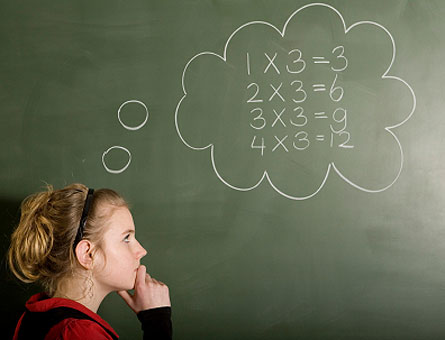Math is a real brain bender
Learning mathematics may make the brain reorganize the way it works
Share this:
- Share via email (Opens in new window) Email
- Click to share on Facebook (Opens in new window) Facebook
- Click to share on X (Opens in new window) X
- Click to share on Pinterest (Opens in new window) Pinterest
- Click to share on Reddit (Opens in new window) Reddit
- Share to Google Classroom (Opens in new window) Google Classroom
- Click to print (Opens in new window) Print
By Emily Sohn
 |
|
Practicing arithmetic may cause the brain to restructure its processes, helping kids move from rough estimates to symbolic, precise math at older ages. |
| BartCo / iStockphoto |
Don’t feel bad if it took forever to wrap your brain around math. Mastering arithmetic requires major reorganization in the way the brain works.
As kids grow up, the parts of the brain used to do math problems change. In elementary school kids, a region of the brain called the prefrontal cortex lights up while doing arithmetic.
But by the time kids become adults, that region takes a backseat when crunching numbers, and another part of the brain, called the left superior temporal gyrus, kicks in. A nearby region called the parietal cortex also plays a bigger role in adults’ calculations.
Scientists have shown that the left superior temporal gyrus may help connect the sounds of speech to written letters. The region may also get in gear when you play an instrument, helping you link the sound of your clarinet solo to the notes written on sheet music. It’s possible that this part of the brain helps adults tie the symbols for numbers to precise amounts, says Daniel Ansari, of the University of Western Ontario in London, Canada. Ansari and his colleagues conducted the study that uncovered the shift in brain regions used for math.
To understand how the brain tackles math at different ages, Ansari’s team matched 19 children, ages 6 to 9, with 19 adults, ages 18 to 24. The researchers showed both groups pairs of written numbers from one to 10, and then asked the kids and adults to say which number was bigger. Next, the people were shown pairs of images — each one with a group of one to 10 squares. The volunteers were asked to say which image in the pair had more squares. During the experiment, the scientists took pictures of the participants’ brains using a functional MRI scanner. This machine measures blood flow, which offers clues about the activity of certain regions of the participants’ brains during each task.
Adults performed the tasks better than children, but it took everyone longer to choose the bigger amount when the difference between the numbers was smaller. (For instance, deciding if two squares is more than three squares was harder than comparing one square and nine squares.)
The scientists found that as the numbers got closer together, the parietal cortex got more active in adults, but didn’t rev up in kids’ brains.
“Our results demonstrate that the brain basis of number processing changes as a function of development and experience,” Ansari says.
The findings suggest that people’s ability to link symbols with precise quantities builds on an older system used to gauge rough amounts. Animals like monkeys use this older number sense, for instance, to estimate the better deal when choosing between handfuls of sunflower seeds.
After many years of math problems, however, people’s parietal cortex takes over from the older system, jumpstarting translation of approximate amounts into symbolic, precise numerals. And after even more practice, the left superior temporal gyrus takes over major math tasks, Ansari suspects.
Going Deeper:







